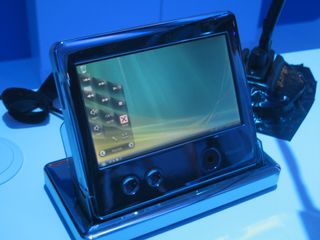Ultra-mobile Intel chip gets HyperThreading
Tiny CPU to packs the performance of a Pentium M processor

Intel's upcoming Silverthorne ultra-mobile CPU will resurrect HyperThreading technology. Last seen on Pentium 4 Netburst chips, HyperThreading allows a single processor core to simultaneously process two software threads.
Intel also revealed that the new 45nm mobile processor will be based on a relatively simple "in-order" execution core. All of Intel's desktop and mobile processors have been "out-of-order" architectures since the launch of the Pentium Pro in 1995.
Silverthorne is part of Intel's new Menlow low power platform designed for use with ultra-mobile PCs (UMPCs) and mobile internet devices (MIDs). Due for release in the first half of 2008, Intel claims Silverthorne offers a revolutionary improvement in power consumption at the same time as being fully compatible with the instruction set used by the Core 2 desktop and laptop chips.
In other words, any application or operating system written for Intel's Core 2 processors will run on Silverthorne without the need for recompiling or tweaking.
A parsimonious little processor
The Silverthorne CPU is expected to reduce power consumption to the 0.5 to 2W range. The Ultra Low Voltage Core Solo laptop chip, the most power efficient processor Intel currently offers, is rated at 5W.
So, Silverthorne should be Intel's most efficient processor yet. But what about number crunching grunt? Speaking to Tech.co.uk, Intel CTO Justin Ratner said Silverthorne's performance will be "in the same range as our early Banias Centrino processor."
That's extremely impressive, if true. Banias, also known as the first Pentium M processor, is a pretty gutsy performer, even by today's standards. However, until Intel releases further details of the chip's architecture, it's hard to imagine quite how this feat has been pulled off.
Get daily insight, inspiration and deals in your inbox
Get the hottest deals available in your inbox plus news, reviews, opinion, analysis and more from the TechRadar team.
Out of order?
Here's the problem. There's a reason why Intel abandoned in-order processors back in the 90s. They tend to suffer from much more frequent stalls due to lack of data than more flexible out-of-order architectures. And more stalls means less work done per cycle and lower overall performance.
However, the advantage of in-order designs is reduced complexity and in turn lower power consumption. Handy for a mobile chip. Consequently, it's been possible to peg Silverthorne's transistor count at just 40 million. That's around 1/10th the number of Intel's 45nm dual-core desktop processors. Even the elderly Banias chip required 77 million transistors.
However, the performance short comings of Silverthorne's in-order design might explain why HyperThreading is making a comeback. Granted HyperThreading won't offer the same performance boost as a fully dual-core processor.
But the ability to switch software threads whenever a delay occurs might just offset the latency associated with in-order execution. It's an approach that Intel already uses for its Itanium enterprise CPUs, which are also in-order designs.
Whatever the case, Silverthorne is a seriously exciting new chip. We're certainly looking forward to see if it can deliver on the promise of desktop-class x86 in pocket-sized form factors and all-day battery life.
Technology and cars. Increasingly the twain shall meet. Which is handy, because Jeremy (Twitter) is addicted to both. Long-time tech journalist, former editor of iCar magazine and incumbent car guru for T3 magazine, Jeremy reckons in-car technology is about to go thermonuclear. No, not exploding cars. That would be silly. And dangerous. But rather an explosive period of unprecedented innovation. Enjoy the ride.
Most Popular





